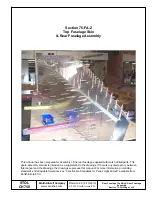
6
and reactions. This would therefore effect the glider’s confi guration and
would not conform to the certifi cation.
2.5 ASSEMBLY OF THE ACCELERATOR
The acceleration mechanism of the PEAK works when you push with your
feet on the accelerator bar, this is supplied with the equipment. On delivery
the accelerator bar has not yet been installed and it is recommended that it
is fi t by your self before fl ight. Most harnesses are equipped with a pre-
installed acceleration system. When fi tting any accelerator system ensure
that all preinstalled items within the harness, such as roller pulleys are used
correctly. After fi tting, take into account that you will have to adjust the length
of the accelerator lines for correct use. This will vary according to the length
of the pilot’s legs!
We recommend that you try the correct fi tting of the acceleration system on
equipment designed to do this, most paragliding schools have this sort of
equipment.
2.6 INSPECTION AND WING INFLATION ON THE GROUND
Once you have checked all the equipment and made sure that the wind
conditions are favourable, infl ate your PEAK as many times as necessary in
order to become acquainted with the wing’s behaviour. The PEAK infl ates
easily and smoothly. An excess of energy is not necessary and the wing will
infl ate with minimum pressure on the harness when you move forward. This
may be assisted by using the A lines. Do not pull on them, just accompany
the natural rising movement of the wing. Once the wing is in the 12 o’clock
position, simply apply correct pressure on the brake lines and the PEAK will
sit over your head.
2.7 ADJUSTING THE BRAKES
The length of the main brake lines is adjusted at the factory to the length
established during certifi cation. However, the length can be changed to
adapt to the pilot’s fl ying style. Nevertheless, we recommend that you fl y for
a while with these, set at the original length. This will allow you to become
accustomed to the PEAK and it’s unique fl ying behaviour. If you then
decide to change the length of the brake lines, untie the knot, slide the line
through the brake link to the desired length, and strongly re-tie the knot.
Qualifi ed personnel should carry out this adjustment. You must ensure that
this adjustment does not slow down the glider without any pilot input. Both
brake lines should be symmetrical and measure the same length. The most
recommended knots are the clove hitch knot or bowline knot.
3. THE FIRST FLIGHT
3.1 CHOOSE THE RIGHT PLACE
We recommend that the fi rst fl ight with your PEAK is made on a smooth slope
(a school slope) or in your usual fl ying area.
3.2 PREPARATION
Repeat the procedures detailed in chapter 2 (UNPACKING AND ASSEMBLY)
in order to prepare your PEAK.
3.3 FLIGHT PLAN
Draw out a fl ight plan before take-off in order to avoid possible fl ight errors.
3.4 PRE-FLIGHT CHECK LIST
Once you are ready, but before you take-off, carry out another equipment
inspection. Ensure correct installation of all equipment and that all lines are
free of hindrances or knots. Check that the weather conditions are suited for
your fl ying skills.
Summary of Contents for PEAK 23
Page 1: ...PEAK USER S MANUAL...
Page 14: ...14 11 3 RISER ARRANGEMENT PEAK...
Page 15: ...15 11 4 LINE PLAN PEAK...
Page 20: ...niviuk com The importance of small details Bisgr c...


































